当前位置:网站首页>Reading notes of cgnf: conditional graph neural fields
Reading notes of cgnf: conditional graph neural fields
2022-07-02 05:47:00 【Si Xi is towering】
One . An overview of the article
In most GNNs in , The dependency between node labels is not considered . So , The author puts the conditional random field (Conditional Random Fields, CRF) And graph convolution network CGNF(Conditional Graph Neural Network), This model explicitly models the joint probability of the whole node label set , thus The neighborhood label information can be used in the node label prediction task .
Two . Background knowledge
2.1 Figure convolution network
GCN The mathematical form of convolution in the middle map is as follows :
H ( l + 1 ) = σ ( D ~ − 1 2 A ~ D ~ − 1 2 H ( l ) W ( l ) ) \boldsymbol{H}^{(l+1)}=\sigma\left(\tilde{\boldsymbol{D}}^{-\frac{1}{2}} \tilde{\boldsymbol{A}} \tilde{\boldsymbol{D}}^{-\frac{1}{2}} \boldsymbol{H}^{(l)} \boldsymbol{W}^{(l)}\right) H(l+1)=σ(D~−21A~D~−21H(l)W(l))
among A ~ = A + I \tilde{A}=\boldsymbol{A}+\boldsymbol{I} A~=A+I Represents the adjacency matrix with self ring added , D ~ \tilde{D} D~ yes A ~ \tilde{A} A~ The corresponding degree matrix ( Diagonal matrix ), H ( l ) \boldsymbol{H}^{(l)} H(l) It means the first one l l l The node representation of the layer , W ( l ) \boldsymbol{W}^{(l)} W(l) It means the first one l l l Layer weight matrix , σ \sigma σ Is the activation function , The common one is ReLU.
2.2 Conditional random field
Conditional random field (CRF) It's a kind of Undirected probability graph model , Usually used for structural prediction tasks . Given the input characteristics x ∈ R d x \in \mathbb{R}^{d} x∈Rd,CRF To find the maximum conditional probability P ( y ∣ x ) P(\boldsymbol{y} \mid \boldsymbol{x}) P(y∣x) Tag set y \boldsymbol{y} y. On an undirected graph ,CRF The way to calculate the joint probability distribution is Factorization , namely :
P ( y ∣ x ) = 1 Z ( x ) ∏ c Φ a ( x c , y c ) P(\boldsymbol{y} \mid \boldsymbol{x})=\frac{1}{Z(\boldsymbol{x})} \prod_{c} \Phi_{a}\left(\boldsymbol{x}_{c}, \boldsymbol{y}_{c}\right) P(y∣x)=Z(x)1c∏Φa(xc,yc)
among c c c Represents the group in the figure , x c \boldsymbol{x}_{c} xc Express Group c c c Features corresponding to all vertices in , Φ c \Phi_{c} Φc Represents the potential function , Z ( x ) = ∑ y c ′ ∏ c Φ a ( x c , y c ′ ) Z(\boldsymbol{x})=\sum_{\boldsymbol{y}_{c}^{\prime}} \prod_{c} \Phi_{a}\left(\boldsymbol{x}_{c}, \boldsymbol{y}_{c}^{\prime}\right) Z(x)=∑yc′∏cΦa(xc,yc′) Denotes the normalization factor ( It is used to ensure that the calculated probability value is legal ).
Clique refers to a subgraph in which all vertices have edge connections .
3、 ... and .CGNF Detailed introduction
First, the symbol table is given for the convenience of subsequent introduction :
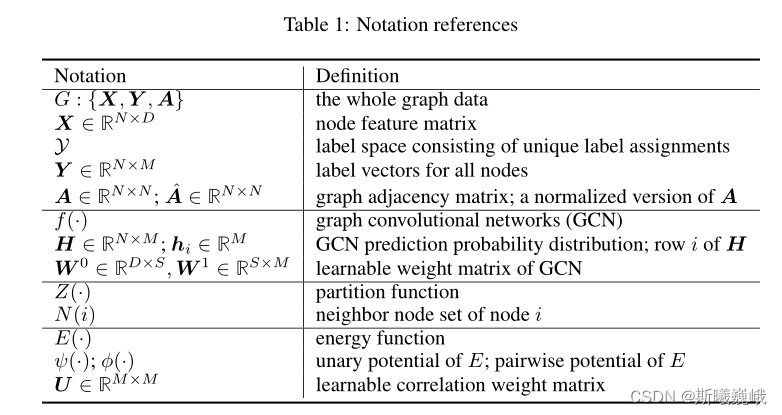
3.1 Training
CGNF The first step is to input the graph G = { X , Y , A } G=\{\boldsymbol{X}, \boldsymbol{Y}, \boldsymbol{A}\} G={ X,Y,A} Later Kipf and Welling Bring up the 2 layer GCN Model , namely :
H = f ( X , A ) = Softmax ( A ^ ReLu ( A ^ X W 0 ) W 1 ) \boldsymbol{H}=f(\boldsymbol{X}, \boldsymbol{A})=\operatorname{Softmax}\left(\hat{\boldsymbol{A}} \operatorname{ReLu}\left(\hat{\boldsymbol{A}} \boldsymbol{X} \boldsymbol{W}^{0}\right) \boldsymbol{W}^{1}\right) H=f(X,A)=Softmax(A^ReLu(A^XW0)W1)
And then , The author considers the influence of node characteristics and label dependency , Define the energy function (energy function) as follows :
E ( Y , X , A ) = E c ( Y c , X c , A ) = ∑ i ψ ( y i , x i ) + γ ∑ ( i , j ) ∈ E , i < j ϕ ( y i , y j , A i , j ) E(\boldsymbol{Y}, \boldsymbol{X}, \boldsymbol{A})=E_{c}\left(\boldsymbol{Y}_{c}, \boldsymbol{X}_{c}, \boldsymbol{A}\right)=\sum_{i} \psi\left(\boldsymbol{y}_{i}, \boldsymbol{x}_{i}\right)+\gamma \sum_{(i, j) \in \mathcal{E}, i<j} \phi\left(\boldsymbol{y}_{i}, \boldsymbol{y}_{j}, A_{i, j}\right) E(Y,X,A)=Ec(Yc,Xc,A)=i∑ψ(yi,xi)+γ(i,j)∈E,i<j∑ϕ(yi,yj,Ai,j)
among c c c Express Group , E \mathcal{E} E Represents an edge set , ψ ( ⋅ ) \psi(\cdot) ψ(⋅) by The univariate potential function ( Used for policy observation nodes x i x_i xi And labels y i y_i yi Compatibility between compatibility, namely The observed value is x i x_i xi Belong to y i y_i yi The probability of a class ), Pairwise potential function ϕ ( ⋅ ) \phi(\cdot) ϕ(⋅) Used to capture tag Correlation . Based on this energy function , Can export Gibbs Distribution :
P ( Y ∣ X , A ) = exp ( − E ( Y , X , A ) ) ∑ Y ′ ∈ Y exp ( − E ( Y ′ , X , A ) ) = exp ( − E ( Y , X , A ) ) Z ( X , A ) P(\boldsymbol{Y} \mid \boldsymbol{X}, \boldsymbol{A})=\frac{\exp (-E(\boldsymbol{Y}, \boldsymbol{X}, \boldsymbol{A}))}{\sum_{\boldsymbol{Y}^{\prime} \in \mathcal{Y}} \exp \left(-E\left(\boldsymbol{Y}^{\prime}, \boldsymbol{X}, \boldsymbol{A}\right)\right)}=\frac{\exp (-E(\boldsymbol{Y}, \boldsymbol{X}, \boldsymbol{A}))}{Z(\boldsymbol{X}, \boldsymbol{A})} P(Y∣X,A)=∑Y′∈Yexp(−E(Y′,X,A))exp(−E(Y,X,A))=Z(X,A)exp(−E(Y,X,A))
The goal of the author is to maximize the conditional probability , namely :
E ( Y , X , A ) = ∑ i ψ ( y i , h i ) + γ ∑ ( i , j ) ∈ E , i < j ϕ ( y i , y j , A ^ i , j ) = ∑ i ( ψ ( y i , h i ) + γ 2 ∑ j ∈ N ( i ) ϕ ( y i , y j , A ^ i , j ) ) \begin{aligned} E(\boldsymbol{Y}, \boldsymbol{X}, \boldsymbol{A}) &=\sum_{i} \psi\left(\boldsymbol{y}_{i}, \boldsymbol{h}_{\boldsymbol{i}}\right)+\gamma \sum_{(i, j) \in \mathcal{E}, i<j} \phi\left(\boldsymbol{y}_{i}, \boldsymbol{y}_{j}, \hat{A}_{i, j}\right) \\ &=\sum_{i}\left(\psi\left(\boldsymbol{y}_{i}, \boldsymbol{h}_{i}\right)+\frac{\gamma}{2} \sum_{j \in N(i)} \phi\left(\boldsymbol{y}_{i}, \boldsymbol{y}_{j}, \hat{A}_{i, j}\right)\right) \end{aligned} E(Y,X,A)=i∑ψ(yi,hi)+γ(i,j)∈E,i<j∑ϕ(yi,yj,A^i,j)=i∑⎝⎛ψ(yi,hi)+2γj∈N(i)∑ϕ(yi,yj,A^i,j)⎠⎞
among h i h_i hi It's through 2 layer GCN The node representation obtained by the model , A ^ i , j \hat{A}_{i, j} A^i,j Is the original in the regularized adjacency matrix , N ( i ) N(i) N(i) Is the node i i i The neighborhood of . The calculation formula of the two potential functions is as follows :
ψ ( y i , h i ) = − log p ( y i ∣ h i ) = − ∑ k y i , k log h i , k ϕ ( y i , y j , A ^ i , j ) = − 2 A ^ i , j U y i , y j \begin{aligned} \psi\left(\boldsymbol{y}_{i}, \boldsymbol{h}_{i}\right) &=-\log p\left(\boldsymbol{y}_{i} \mid \boldsymbol{h}_{i}\right)=-\sum_{k} y_{i, k} \log h_{i, k} \\ \phi\left(\boldsymbol{y}_{i}, \boldsymbol{y}_{j}, \hat{A}_{i, j}\right) &=-2 \hat{A}_{i, j} U_{y_{i}, y_{j}} \end{aligned} ψ(yi,hi)ϕ(yi,yj,A^i,j)=−logp(yi∣hi)=−k∑yi,kloghi,k=−2A^i,jUyi,yj
It can be seen from the above formula that ψ ( y i , h i ) \psi\left(\boldsymbol{y}_{i}, \boldsymbol{h}_{i}\right) ψ(yi,hi) It's actually cross entropy , U y i , y j ∈ U U_{y_{i}, y_{j}} \in \boldsymbol{U} Uyi,yj∈U yes label y i y_i yi and y j y_j yj Learnable correlation weights between . Adopt a similar tradition CRF How to do it , The author uses negative log likelihood as the objective function of training :
− log P ( Y ∣ X , A ) = E ( Y , X , A ) + log Z ( X , A ) = E ( Y , X , A ) + log ∑ Y ′ exp ( − E ( Y ′ , X , A ) ) \begin{aligned} -\log P(\boldsymbol{Y} \mid \boldsymbol{X}, \boldsymbol{A}) &=E(\boldsymbol{Y}, \boldsymbol{X}, \boldsymbol{A})+\log Z(\boldsymbol{X}, \boldsymbol{A}) \\ &=E(\boldsymbol{Y}, \boldsymbol{X}, \boldsymbol{A})+\log \sum_{\boldsymbol{Y}^{\prime}} \exp \left(-E\left(\boldsymbol{Y}^{\prime}, \boldsymbol{X}, \boldsymbol{A}\right)\right) \end{aligned} −logP(Y∣X,A)=E(Y,X,A)+logZ(X,A)=E(Y,X,A)+logY′∑exp(−E(Y′,X,A))
In inferring (inference) When , just min Y E ( Y , X , A ) \min _{\boldsymbol{Y}} E(\boldsymbol{Y}, \boldsymbol{X}, \boldsymbol{A}) minYE(Y,X,A) that will do . But it is more difficult to optimize than the above training objectives , For this reason, the author adopts Pseudo likelihood To approximate it :
P ( Y ∣ X , A ) ≈ P L ( Y ∣ X , A ) = ∏ i P ( y i ∣ y N ( i ) , X , A ) P(\boldsymbol{Y} \mid \boldsymbol{X}, \boldsymbol{A}) \approx P L(\boldsymbol{Y} \mid \boldsymbol{X}, \boldsymbol{A})=\prod_{i} P\left(\boldsymbol{y}_{i} \mid \boldsymbol{y}_{N(i)}, \boldsymbol{X}, \boldsymbol{A}\right) P(Y∣X,A)≈PL(Y∣X,A)=i∏P(yi∣yN(i),X,A)
among :
P ( y i ∣ y N ( i ) , X , A ) = exp ( − ψ ( y i , h i ) − γ ∑ j ∈ N ( i ) ϕ ( y i , y j , A ^ i , j ) ∑ y i ′ ( exp ( − ψ ( y i ′ , h i ) − γ ∑ j ∈ N ( i ) ϕ ( y i ′ , y j , A ^ i , j ) ) = exp ( − log p ( y i ∣ h i ) − 2 γ ∑ j ∈ N ( i ) A ^ i , j U y i , y j ∑ y i ′ ( exp ( − log p ( y i ′ ∣ h i ) − 2 γ ∑ j ∈ N ( i ) A ^ i , j U y i ′ , y j ) \begin{aligned} P\left(\boldsymbol{y}_{i} \mid \boldsymbol{y}_{N(i)}, \boldsymbol{X}, \boldsymbol{A}\right) &=\frac{\exp \left(-\psi\left(\boldsymbol{y}_{i}, \boldsymbol{h}_{\boldsymbol{i}}\right)-\gamma \sum_{j \in N(i)} \phi\left(\boldsymbol{y}_{i}, \boldsymbol{y}_{j}, \hat{A}_{i, j}\right)\right.}{\sum_{\boldsymbol{y}_{i}^{\prime}}\left(\exp \left(-\psi\left(\boldsymbol{y}_{i}^{\prime}, \boldsymbol{h}_{\boldsymbol{i}}\right)-\gamma \sum_{j \in N(i)} \phi\left(\boldsymbol{y}_{i}^{\prime}, \boldsymbol{y}_{j}, \hat{A}_{i, j}\right)\right)\right.} \\ &=\frac{\exp \left(-\log p\left(\boldsymbol{y}_{i} \mid \boldsymbol{h}_{\boldsymbol{i}}\right)-2 \gamma \sum_{j \in N(i)} \hat{A}_{i, j} U_{y_{i}, y_{j}}\right.}{\sum_{\boldsymbol{y}_{i}^{\prime}}\left(\exp \left(-\log p\left(\boldsymbol{y}_{i}^{\prime} \mid \boldsymbol{h}_{\boldsymbol{i}}\right)-2 \gamma \sum_{j \in N(i)} \hat{A}_{i, j} U_{y_{i}^{\prime}, y_{j}}\right)\right.} \end{aligned} P(yi∣yN(i),X,A)=∑yi′(exp(−ψ(yi′,hi)−γ∑j∈N(i)ϕ(yi′,yj,A^i,j))exp(−ψ(yi,hi)−γ∑j∈N(i)ϕ(yi,yj,A^i,j)=∑yi′(exp(−logp(yi′∣hi)−2γ∑j∈N(i)A^i,jUyi′,yj)exp(−logp(yi∣hi)−2γ∑j∈N(i)A^i,jUyi,yj
y i ′ \boldsymbol{y}_{i}^{\prime} yi′ Is the node x i \boldsymbol{x}_{i} xi All possible labels . therefore , The new training goal is :
− log P L ( Y ∣ X , A ) = ∑ i − log P ( y i ∣ y N ( i ) , X , A ) = ∑ i ( ψ ( y i , h i ) + γ ∑ j ∈ N ( i ) ϕ ( y i , y j , A ^ i , j ) + log ∑ y i ′ ( exp ( − ψ ( y i ′ , h i ) − γ ∑ j ∈ N ( i ) ϕ ( y i ′ , y j , A ^ i , j ) ) ) = − ∑ i , k ( Y ⊙ log H ) i , k − 2 γ ∑ i , j , i ≠ j ( A ^ ⊙ ( Y U Y T ) ) i , j + ∑ i log ∑ k ( H ⊙ exp ( 2 γ A ^ Y U ) ) i , k \begin{aligned} &-\log P L(\boldsymbol{Y} \mid \boldsymbol{X}, \boldsymbol{A})=\sum_{i}-\log P\left(\boldsymbol{y}_{i} \mid \boldsymbol{y}_{N(i)}, \boldsymbol{X}, \boldsymbol{A}\right)= \\ &\sum_{i}\left(\psi\left(\boldsymbol{y}_{i}, \boldsymbol{h}_{i}\right)+\gamma \sum_{j \in N(i)} \phi\left(\boldsymbol{y}_{i}, \boldsymbol{y}_{j}, \hat{A}_{i, j}\right)+\log \sum_{\boldsymbol{y}_{i}^{\prime}}\left(\exp \left(-\psi\left(\boldsymbol{y}_{i}^{\prime}, \boldsymbol{h}_{\boldsymbol{i}}\right)-\gamma \sum_{j \in N(i)} \phi\left(\boldsymbol{y}_{i}^{\prime}, \boldsymbol{y}_{j}, \hat{A}_{i, j}\right)\right)\right)\right. \\ &=-\sum_{i, k}(\boldsymbol{Y} \odot \log \boldsymbol{H})_{i, k}-2 \gamma \sum_{i, j, i \neq j}\left(\hat{\boldsymbol{A}} \odot\left(\boldsymbol{Y} \boldsymbol{U} \boldsymbol{Y}^{T}\right)\right)_{i, j}+\sum_{i} \log \sum_{k}(\boldsymbol{H} \odot \exp (2 \gamma \hat{\boldsymbol{A}} \boldsymbol{Y} \boldsymbol{U}))_{i, k} \end{aligned} −logPL(Y∣X,A)=i∑−logP(yi∣yN(i),X,A)=i∑⎝⎛ψ(yi,hi)+γj∈N(i)∑ϕ(yi,yj,A^i,j)+logyi′∑⎝⎛exp⎝⎛−ψ(yi′,hi)−γj∈N(i)∑ϕ(yi′,yj,A^i,j)⎠⎞⎠⎞=−i,k∑(Y⊙logH)i,k−2γi,j,i=j∑(A^⊙(YUYT))i,j+i∑logk∑(H⊙exp(2γA^YU))i,k
⊙ \odot ⊙ Represents element by element multiplication .
3.2 infer
As mentioned above , When inferring, you only need to optimize the following objectives :
min Y ^ t e E ( Y ^ t e , X , A , Y t r ) = min Y ^ t e [ − log p ( Y ^ t e ∣ H ) − γ ∑ i ≠ j ( A ^ ⊙ ( Y ^ U Y ^ T ) ) i , j ] \min _{\hat{\boldsymbol{Y}}_{t e}} E\left(\hat{\boldsymbol{Y}}_{t e}, \boldsymbol{X}, \boldsymbol{A}, \boldsymbol{Y}_{t r}\right)=\min _{\hat{\boldsymbol{Y}}_{t e}}\left[-\log p\left(\hat{\boldsymbol{Y}}_{t e} \mid \boldsymbol{H}\right)-\gamma \sum_{i \neq j}\left(\hat{\boldsymbol{A}} \odot\left(\hat{\boldsymbol{Y}} \boldsymbol{U} \hat{\boldsymbol{Y}}^{T}\right)\right)_{i, j}\right] Y^teminE(Y^te,X,A,Ytr)=Y^temin⎣⎡−logp(Y^te∣H)−γi=j∑(A^⊙(Y^UY^T))i,j⎦⎤
among Y ^ = \hat{\boldsymbol{Y}}= Y^= concatenate ( Y t r , Y ^ t e ) \left(\boldsymbol{Y}_{t r}, \hat{\boldsymbol{Y}}_{t e}\right) (Ytr,Y^te). The author mentioned two inference methods in his paper .
3.2.1 Inference method 1
The simplest inference method is to ignore the correlation between tags , namely :
y i = arg min y j E ( y i , Y t r , X , A ) = arg min j [ − log ( h i ) − 2 γ A ^ t r Y U T ] j y_{i}=\underset{y_{j}}{\arg \min } E\left(\boldsymbol{y}_{i}, \boldsymbol{Y}_{t r}, \boldsymbol{X}, \boldsymbol{A}\right)=\underset{j}{\arg \min }\left[-\log \left(\boldsymbol{h}_{i}\right)-2 \gamma \hat{\boldsymbol{A}}_{t r} \boldsymbol{Y} \boldsymbol{U}^{T}\right]_{j} yi=yjargminE(yi,Ytr,X,A)=jargmin[−log(hi)−2γA^trYUT]j
3.2.2 Inference method 2
The second scheme is to use dynamic programming method to find the optimal value . This method will randomly select a test node as the start , And randomly sort other test nodes , Then follow the order of sorting test nodes beam search(beam The size is K K K, That is, you can get K K K Best set ). Repeat the process T T T word , Then select the best of all search results , The algorithm is summarized as follows :

Four . experiment
The author in Cora、Pubmed、Citeseer and PPI Experiment on four data sets , And compared with others baseline Good performance has been achieved , The corresponding results are as follows :

Conclusion
Reference material :
边栏推荐
- ThreadLocal memory leak
- Detailed explanation of Pointer use
- Foreign trade marketing website system development function case making
- Simply encapsulate JS and apply it
- Technologists talk about open source: This is not just using love to generate electricity
- 3D 打印机 G 代码命令:完整列表和教程
- js判断移动端还是pc端
- Installation du tutoriel MySQL 8.0.22 par centos8
- vite如何兼容低版本浏览器
- Thread pool batch processing data
猜你喜欢
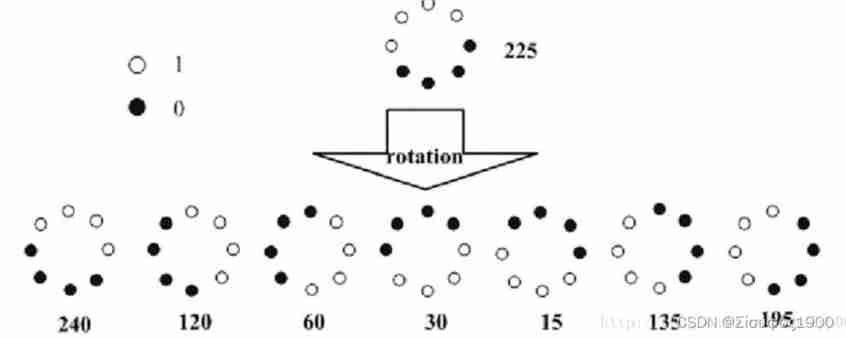
Opencv LBP features

Importation de studio visuel

Installation du tutoriel MySQL 8.0.22 par centos8

死磕大屏UI,FineReport开发日记
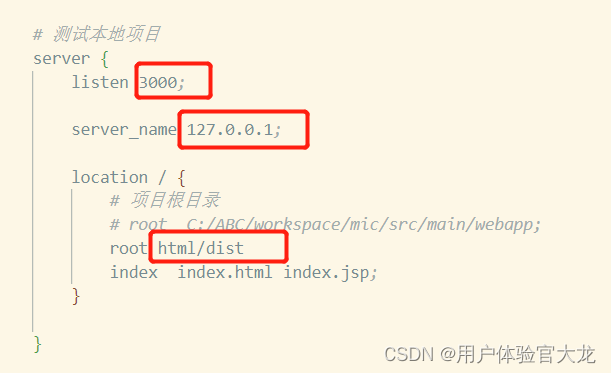
Vite打包后的dist不能直接在浏览器打开吗
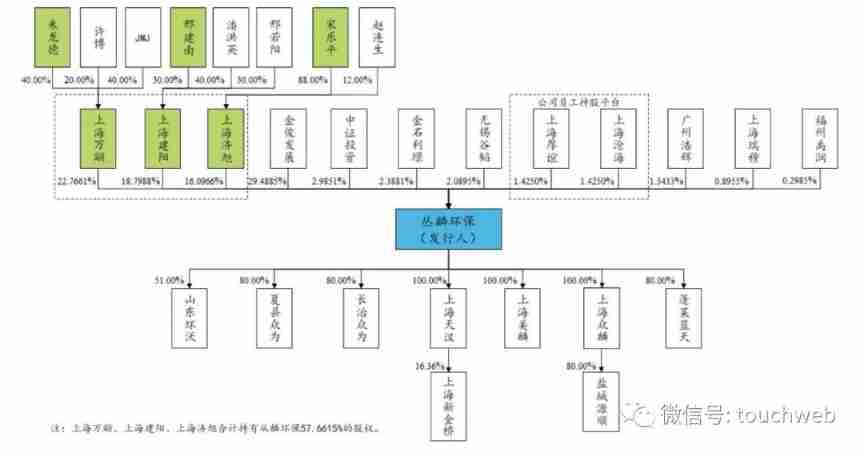
Conglin environmental protection rushes to the scientific and Technological Innovation Board: it plans to raise 2billion yuan, with an annual profit of more than 200million yuan
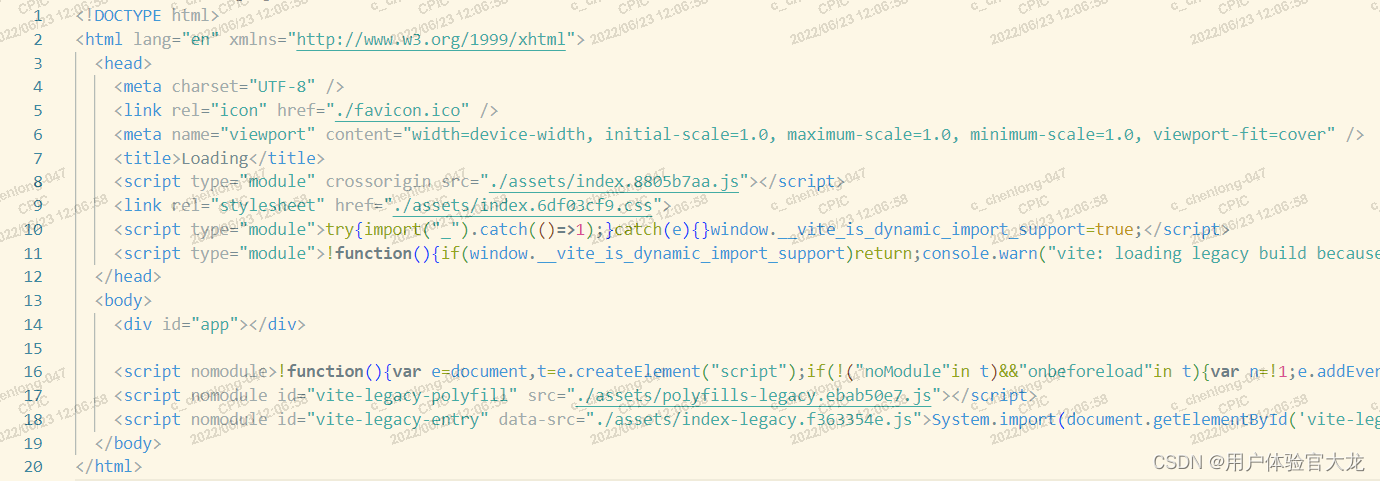
vite如何兼容低版本浏览器
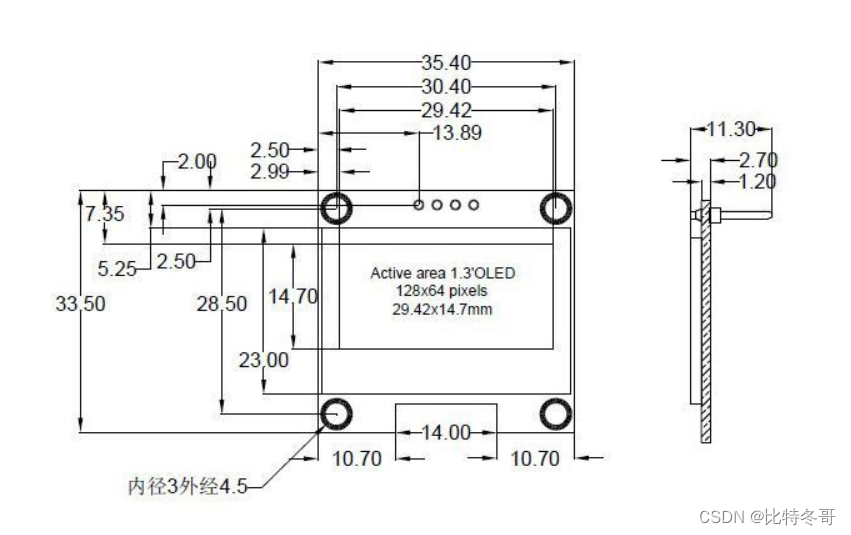
Oled12864 LCD screen

Detailed explanation of Pointer use

Lingyunguang rushes to the scientific innovation board: the annual accounts receivable reaches 800million. Dachen and Xiaomi are shareholders
随机推荐
Fabric. JS activation input box
Storage of data
Oled12864 LCD screen
Fabric. JS right click menu
Fabric. JS free draw rectangle
Fabric. JS upload local image to canvas background
死磕大屏UI,FineReport开发日记
idea開發工具常用的插件合集匯總
Fabric. JS iText superscript and subscript
Fabric. JS 3 APIs to set canvas width and height
来啦~ 使用 EasyExcel 导出时进行数据转换系列新篇章!
Pytorch Basics
Zzuli:1065 count the number of numeric characters
Fabric. JS three methods of changing pictures (including changing pictures in the group and caching)
Get the details of the next largest number
[golang syntax] be careful with the copy of slices
Uva548 tree
Simply encapsulate JS and apply it
all3dp. All Arduino projects in com website (2022.7.1)
软件测试基础篇